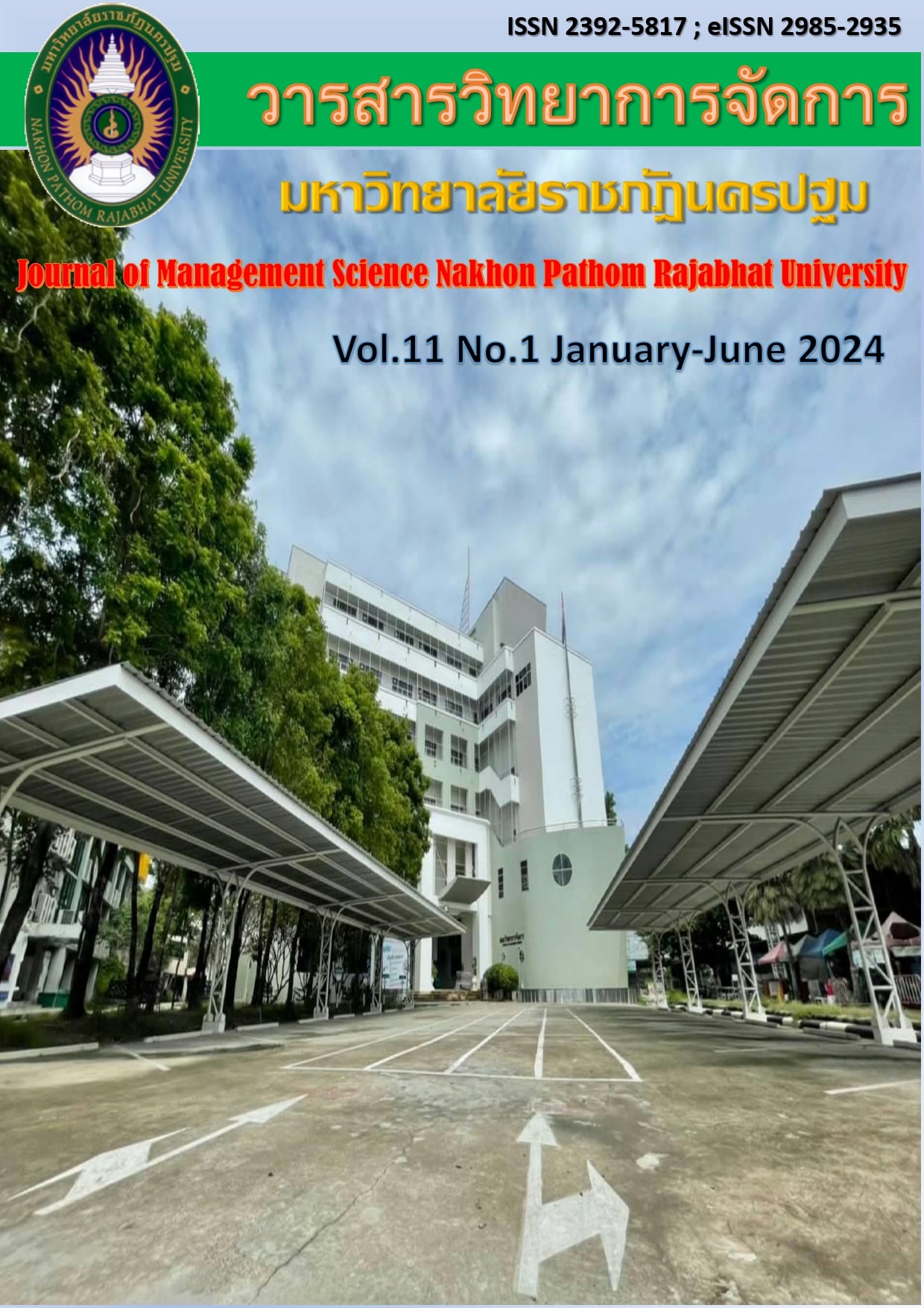Components of Transportation Management for Ornamental Fish Farmers in Nakhon Pathom Province
Main Article Content
Abstract
The research findings indicate that:
1. The analysis of transportation management components for ornamental fish farmers in Nakhon Pathom Province revealed that the highest weighted factor in the first-order analysis was the reliability of the transportation service providers. In the second-order confirmatory factor analysis, the findings were: (1) In the logistics process dimension, the highest weighted factor was the smooth flow of information, with regular updates and real-time tracking capabilities. (2) In the service accessibility dimension, the highest weighted factor was the ease and speed of contacting the transportation service providers through various channels. (3) In the reliability of the transportation service providers dimension, the highest weighted factor was the credible image of the service providers. (4) In the information technology dimension, the highest weighted factor was the continuous and consistent development of information technology by the service providers.
2. The problems in transportation management for ornamental fish farmers in Nakhon Pathom Province include transportation issues (such as long transport times and lack of tracking systems, leading to unknown status of goods during transit) and cost issues (such as increased costs for food and operations, resulting in reduced profits for farmers and lack of a system for group cost reduction). The solutions suggested include developing standardized containers suitable for transporting ornamental fish, improving the efficiency, speed, and safety of the transportation system, promoting farmer group formations to reduce transportation costs, and developing effective tracking and inspection systems for goods.
Article history: Received 9 May 2024
Revised 11 June 2024
Accepted 13 June 2024
SIMILARITY INDEX = 2.51 %
Article Details

This work is licensed under a Creative Commons Attribution-NonCommercial-NoDerivatives 4.0 International License.
The views and opinions of the article appearing in this journal are those of the author. It is not considered a view and responsibility of the editorial staff.
References
กรมประมง. (ม.ป.ป). การเพาะเลี้ยงปลาทอง. (แผ่นพับ). กรุงเทพฯ : กรมประมง.
เกียรติพงษ์ อุดมธนะธีระ. (2561). Lean ความสูญเสีย 8 ประการ (8 Wastes DOWNTIME). [ออนไลน์] ค้นเมื่อ 24 ตุลาคม 2566. จาก https://www.iok2u.com/index.php/article/industry/243-8-8-wastes-downtime.
คำนาย อภิปรัชญาสกุล. (2556). การการขนส่งสินค้าในงานโลจิสติกส์. กรุงเทพฯ: ดวงกมลสมัย.
สมพล สุขเจริญพงษ์ กนกพัชร วงศ์อินทร์อยู่ และศานติ ดิฐสถาพรเจริญ. (2560). ศักยภาพการผลิต การตลาดปลาสวยงามในประชาคมเศรษฐกิจอาเซียน.Veridian E-Journal, Silpakorn University.10(2).2426-2443.
Akbar, T. (2016). 5 Ways to Enhance Your Logistical Efficiency and Improve Customer Relations. Business 2 Community. [Online]. Retrieved June 11, 2023 from
Borzacchiello, M. T., Torrieri, V., & Nijkamp, P. (2009). An operational information systems architecture for assessing sustainable transportation planning: principles and design. Evaluation and Program Planning, 32(4), 381-389.
Cronbach, L. J. (1970). Essentials of Psychological Testing. New York: Harper & Row.
Genhua, Y. U. E. (2019). The ornamental fish industry in Singapore. Journal of fisheries of china, 43(1), 116-127.
Hair, J.F., Black, W.C., Babin, B.J. and Anderson, R.E. (2010) Multivariate Data Analysis. (7th Ed), New York : Pearson,
Leal, M. C., Vaz, M. C. M., Puga, J., Rocha, R. J. M., Brown, C., Rosa, R., & Calado, R. (2016). Marine ornamental fish imports in the European Union: an economic perspective. Fish and Fisheries, 17 (2), 459-468.
Lim, L. C., Dhert, P., & Sorgeloos, P. (2003). Recent developments and improvements in ornamental fish packaging systems for air transport. Aquaculture Research, 34(11), 923-935.
Marchet, G., Melacini, M., Perotti, S., Rasini, M., & Tappia, E. (2018). Business logistics models in omni-channel: a classification framework and empirical analysis. International Journal of Physical Distribution & Logistics Management, 48(4), 439-464.
Metar, S., Chogale, N., Shinde, K., Satam, S., Sadawarte, V., Sawant, A., ... & Singh, H. (2018). Transportation of live marine ornamental fish. Advanced Agricultural Research & Technology Journal, 2(2), 206-208.
Rattanatat. (2019). Industrial Logistics Performance Index Key Success Factor. [Online]. Retrieved June 11, 2023 from https://dol.dip.go.th/th/category/2019-02-08-08-57-30/2019-03-15-09-09-00
Regragui, Y., & Moussa, N. (2023). A real-time path planning for reducing vehicles traveling time in cooperative-intelligent transportation systems. Simulation Modelling Practice and Theory, 123, 102710.
Stefansson, G., & Lumsden, K. (2009). Performance issues of smart transportation management systems. International Journal of productivity and performance management, 58(1), 55-70.
Tarihoran, A. D. B., Hubeis, M., Jahroh, S., & Zulbainarni, N. (2023). Competitiveness of and Barriers to Indonesia’s Exports of Ornamental Fish. Sustainability, 15(11), 8711.
Thai, V. V. (2008). Service quality in maritime transport: conceptual model and empirical evidence. Asia Pacific Journal of Marketing and Logistics, 20(4), 493-518.
Yue, Z., & Mangan, J. (2023). A framework for understanding reliability in container shipping
networks. Maritime Economics & Logistics, 1-22.

